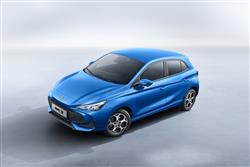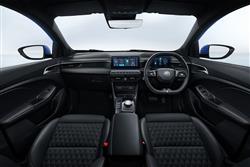MG3 Hybrid+ - ABC Leasing
How will you view?
This is a sample, showing 30 seconds of each section.
CHINESE CHECKER(some text hidden)
By Jonathan Crouch
Ten Second Review word count: 46
The MG3 supermini takes a big step forward in this second generation form. There's now a self charging full-Hybrid powertrain, plus a higher quality cabin, more sophistication and extra interior space. In short, this is a much more credible kind of MG3. But it's still affordable.
Background word count: 156
The original MG3 wasn't the first of this modern era Chinese brand's offerings in Europe but it was the first to sell in any numbers. This little budget supermini was launched back in 2013 and was originally partly British engineered and put together in the old MG Rover factory at Longbridge from kits built in China by parent company SAIC. By the time of the car's extensive update in 2018 though, full Chinese production was in full swing and since that time, MG has become a significant volume player in our market, with much of its growth in EVs. There's no EV version of this second generation MG3, announced in Spring 2024, but this fresh design does offer the brand's first non-plug-in Hybrid and it's that Hybrid+ version we're looking at here. The Chinese makers importers hope to hoover up a lot of customers who would previously have chosen the now-discontinued Fiesta in the supermini segment.
Driving Experience word count: 442
The powertrain here works a little differently than it usually does with self-charging full-Hybrids; first because instead of its electric motor being merely an assistant to a petrol engine, here to some extent at least, it's the other way round. It can be that way because the battery in use here, though still tiny by EV standards, is at 1.83kWh in size considerably larger than it usually is with a small Hybrid of this sort. Which means that the green 'EV' icon on the instrument screen stays on a lot more of the time at suburban speeds. The other thing that's really different about this front-mounted drivetrain is just how powerful it is. That electric motor develops 107bhp and, in combination with the 101bhp 1.5 litre four-cylinder petrol engine it's paired with, means this MG3 has a rather considerable 192bhp to play with; to put that into perspective, mainstream versions of the much pricier Toyota Yaris Hybrid have just 114bhp. Small wonder that this MG is much quicker than its Japanese rival, making 62mph in just 8.0s (1.2s quicker than a Yaris) To replicate that quoted acceleration stat, you will of course have had to engage the most eager of the three provided drive modes - 'Sport' (the other two are 'Normal' and 'Eco'). By which time the green 'EV' light on the instrument display will long ago have been replaced by a 'HEV' icon indicating that the engine is in play. In urban territory, as you'd expect from a petrol/electric small hatch of this sort, EV assistance cuts in and out frequently during town travel to aid efficiency. At these lower speeds, the powertrain always defaults to a full-EV setting, then, when the battery's depleted, it switches to a 'Series' mode that sees the petrol engine quietly wake up to power a generator that tops up the battery with electricity. Surprisingly given the larger battery in play here, there's no 'EV' button like you'd get in a Yaris to force a battery-driven drive setting around town. But unlike with most other small Hybrids, you can select from three levels of brake regeneration to keep the lithium-ion cells topped up. The fiercest of these - 'High' or '3' - slows the car off-throttle quite noticeably. Get beyond the city limits and the powertrain automatically switches to a Parallel Hybrid setting which is where for the first time, the petrol engine sends its power direct to the wheels, in combination with the electric motor via a 3-speed auto gearbox. At speed through the bends, the steering's a little over-light but otherwise handling is quite accomplished, refinement isn't bad and ride quality is excellent.
Pictures (High res disabled)

.jpg)
.jpg)
.jpg)
.jpg)
.jpg)
.jpg)
.jpg)

Scoring
Category: Compact Car
| Performance | |
| Handling | |
| Comfort | |
| Space | |
| Styling | |
| Build | |
| Value | |
| Equipment | |
| Economy | 70% |
| Depreciation | 60% |
| Insurance | 60% |
| Total | 67% |

